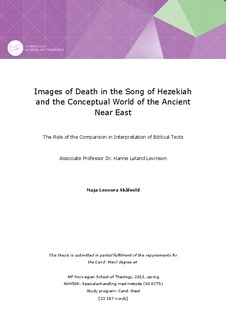Images of Death in the Song of Hezekiah and the conceptual world of the Ancient Near East. The Role of the Comparison in Interpretation of Biblical Texts
Spesialavhandling
Permanent lenke
http://hdl.handle.net/11250/161393Utgivelsesdato
2013-11-21Metadata
Vis full innførselSamlinger
Sammendrag
I have chosen to focus on death, because it is a topic which is fundamentally human and
central to all cultures and religions. Jan Assmann considers death to be the "origin and
center of culture", and argues that human foreknowledge of our own death is what sets
us apart from other living beings.
With different emphases in different times and
different places, death runs through all human attempts at self-understanding, and is the
great unknown. As my starting point, I have chosen a text from the Hebrew Bible in
which the nature of death is one of the main topics, namely the Song of Hezekiah (Isaiah
38:9-20). In this text, the contrast of life and death fuels the central motion of the poem,
and the images of death are rich and varied. The Song is introduced as a writing by the
king at the time of his recovery from a fatal illness and is a first person account of a close
encounter with death. Through varied imagery the song contrasts life and death as it
reflects upon the singer's movement from being close to death to being close to life.
These images, and conceptions they derive from, will be the focus of this thesis, as I ask:
When interpreting Isa 38:9-20, what does comparison with extrabiblical texts and
conceptions add to our interpretation of the images used to depict and contrast life and
death? And what is the added value of comparison with extrabiblical material when
interpreting a biblical text for theological purposes?
